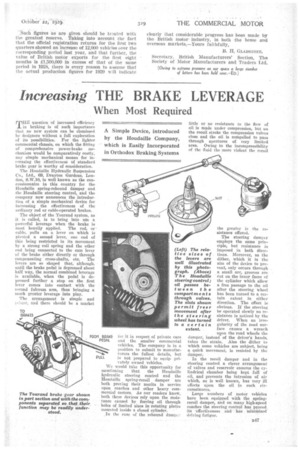Increasing THE BRAKE LEVERAGE
Page 73

If you've noticed an error in this article please click here to report it so we can fix it.
When Most Required
A Simple Device, introduced by the Houdaille Company, which is Easily Incorporated in Orthodox Braking Systems TlIE question of increased efficiency in braking is of such importance that no new system can be dismissed by designers without a full exploration
of its possibilities. For the lighter commercial chassis, on which the fitting of comprehensive power-brake mechanism would be comparatively costly, any simple mechanical means for increasing the effectivenesS Of standard brake gear is worthy of consideration.
The Hondaille Hydraulic Suspension Co., Ltd., 69, Drayton Gardens, London, S.W.10, is well known as the concessionnaire in this country for the Hondaille spring-rebound damper and the HoudailIe steering control, and the company now announces the introduction of a simple mechanical device for increasing . the effectiveness of the ordinary rod or cable-operated brakes.
The object of the Tourand system, as it is called, is to bring into uSe powerful leverage when the brake is
most heavily applied. The rod, or cable, pulls on a lever on which is pivoted a second lever, one end of this being restricted in its movement by a strong coil spring and the other end being connected to the cam lever of the.brake either directly or through compensating cross-shafts, etc. The levers are so shaped that, although, until the brake pedal is depressed about half way, the normal combined leverage is available, when the pedal is depressed further a stop on the first lever comes into contact with the second fulcrum arm, thus bringing a much greater leverage into play.
The arrangement is simple and rr:Imst, and there should he a market for it in respect of private ears PEDAL and the smaller commercial vehicles. The company is in a position to submit to manufacturers the fullest details, but
PULL is not prepared to equip, privately owned vehicles.
We would take this opportunity for mentioning that the Houdaille hydraulic steering control and the Houdaille spring-recoil damper are both proving their merits in service upon coaches and other heavy commercial motors. As our readers know, both these devices rely upon the resistance caused by forcing oil through holes of limited sizes in rotating plates mounted inside a closed cylinder: In the ease of the rebound damp.— FROM Bf2AKE little or no resistance to the flow of oil is made under • compression, but on the recoil stroke the compression valves close and the oil is coMpelled to pass through apertures of very limited area. Owing to the incompressibility of the fluid the more violent the recoil the greater is the resistance offered.
The steering damper employs the same ' Principle, but resistance is imposed in both directions. Moreover, as the dither, which it is the aim of the device to prevent; only occurs through a small arc, grooves are Cut on the inner faces of the cylinder which allow a free passage to the oil after the steering Wheel has been turned to a certain extent in either direction. The effect is obvious. If the steering be operated slowly no resistance is noticed by the driver. When an irregularity of the road surface causes a wrench upon the road wheels the damper, instead of the driver's bands, takes the strain. Also the dither to which some vehicles are subject, being a quick movement, is resisted by the damper..
In the recoil damper and in the steering control a clever arrangement of valves and reservoir ensures the cylindrical chamber being kept full of oil, and prevents the intrusion of air which, as is well known has very ill effects upon the oil in such circumstances.
Large numbers of motor vehicles have been equipped with the springrecoil damper, and on many high-speed coaches the steering contra] has proved itS -6ffeetiveness . and • has minimized driving fatigue. (Left) The relative sizes of the levers are well illustrated by this photograph. (Above) The Houdaille steering control; oil passes between the compartments through valves. The slots shown permit freer movement after the steering wheel has turned to a certain
extent.




















































































































